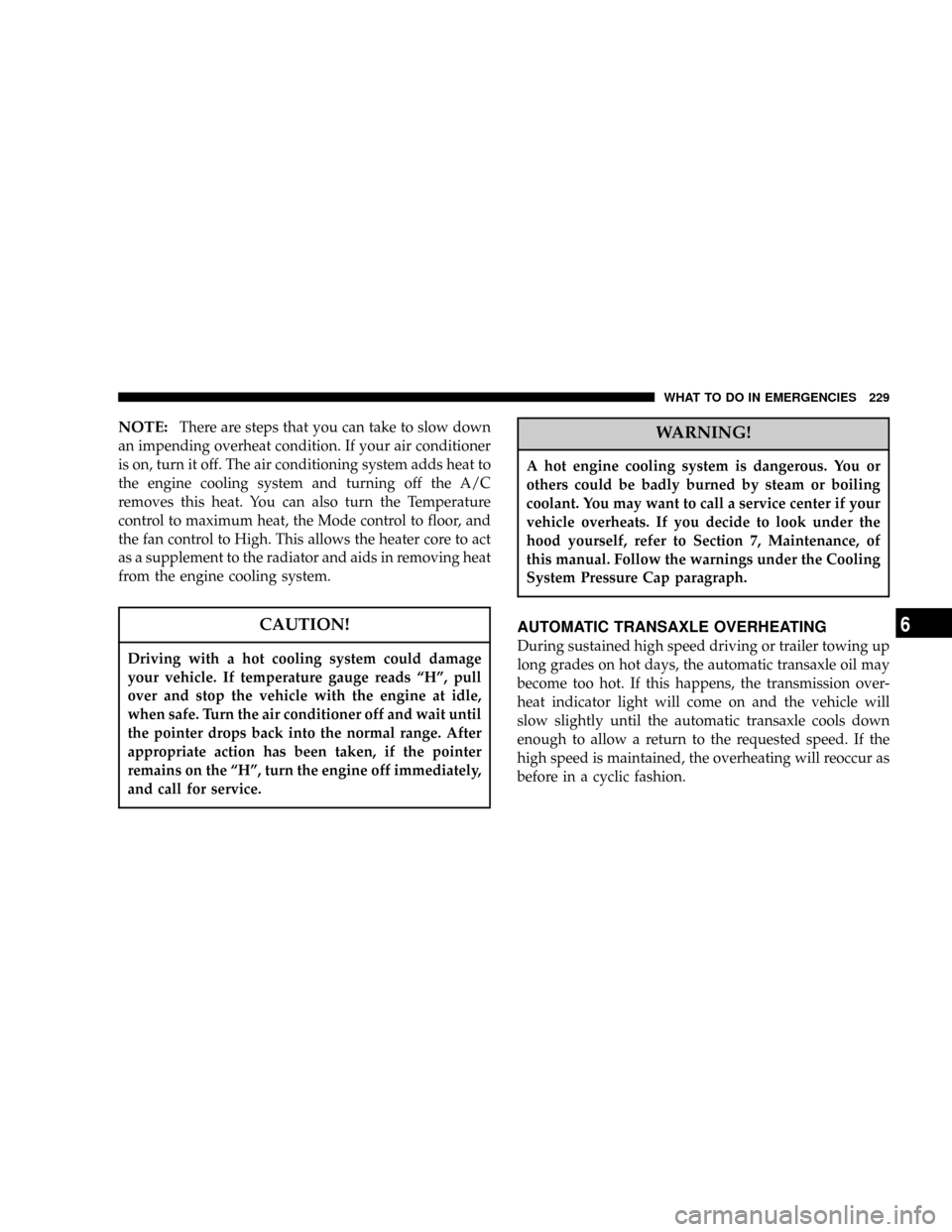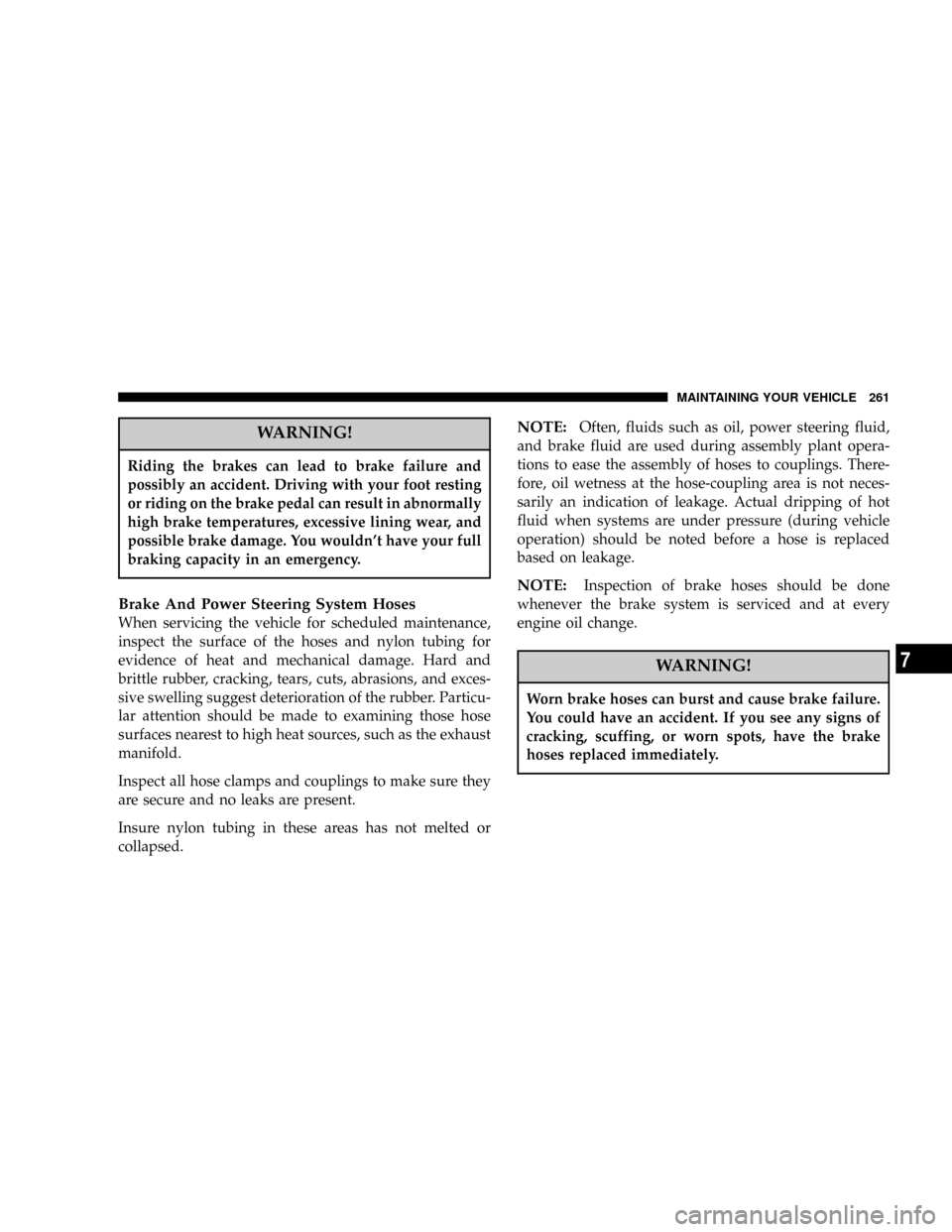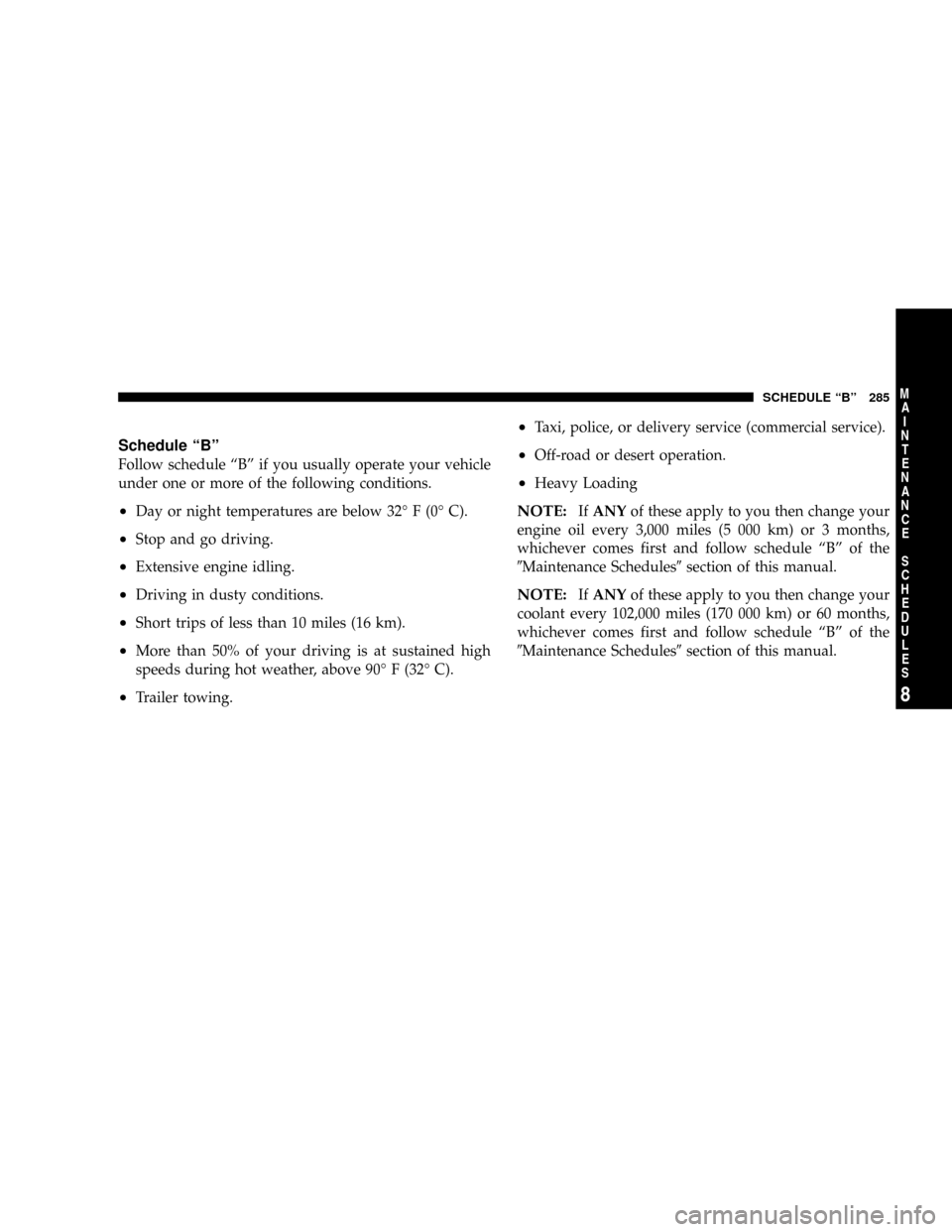oil temperature DODGE CALIBER 2006 1.G Owners Manual
[x] Cancel search | Manufacturer: DODGE, Model Year: 2006, Model line: CALIBER, Model: DODGE CALIBER 2006 1.GPages: 322, PDF Size: 5.99 MB
Page 229 of 322

NOTE:There are steps that you can take to slow down
an impending overheat condition. If your air conditioner
is on, turn it off. The air conditioning system adds heat to
the engine cooling system and turning off the A/C
removes this heat. You can also turn the Temperature
control to maximum heat, the Mode control to floor, and
the fan control to High. This allows the heater core to act
as a supplement to the radiator and aids in removing heat
from the engine cooling system.
CAUTION!
Driving with a hot cooling system could damage
your vehicle. If temperature gauge reads ªHº, pull
over and stop the vehicle with the engine at idle,
when safe. Turn the air conditioner off and wait until
the pointer drops back into the normal range. After
appropriate action has been taken, if the pointer
remains on the ªHº, turn the engine off immediately,
and call for service.
WARNING!
A hot engine cooling system is dangerous. You or
others could be badly burned by steam or boiling
coolant. You may want to call a service center if your
vehicle overheats. If you decide to look under the
hood yourself, refer to Section 7, Maintenance, of
this manual. Follow the warnings under the Cooling
System Pressure Cap paragraph.
AUTOMATIC TRANSAXLE OVERHEATING
During sustained high speed driving or trailer towing up
long grades on hot days, the automatic transaxle oil may
become too hot. If this happens, the transmission over-
heat indicator light will come on and the vehicle will
slow slightly until the automatic transaxle cools down
enough to allow a return to the requested speed. If the
high speed is maintained, the overheating will reoccur as
before in a cyclic fashion.
WHAT TO DO IN EMERGENCIES 229
6
Page 246 of 322

Checking the oil while the vehicle is on level ground and
only when the engine is hot, will improve the accuracy of
the oil level readings. Maintain the oil level between the
range markings on the dipstick. The range markings will
consist of a crosshatch zone that says SAFE or a cross-
hatch zone that says MIN at the low end of the range and
MAX at the high end of the range. Adding one quart of
oil when the reading is at the low end of the indicated
range will result in the oil level at the full end of the
indicator range.
CAUTION!
Do not overfill the engine. Overfilling the engine as
indicated by the range markings, as described above,
on the engine oil dipstick will cause oil aeration,
which can lead to loss of oil pressure and an increase
in oil temperature. This could damage your engine.
Change Engine Oil
Road conditions and your kind of driving affects the
interval at which your oil should be changed. Check the
following list to decide if any apply to you.
²Day and night temperatures are below 32ÉF (0ÉC).
²Stop and Go driving.
²Extensive engine idling.
²Driving in dusty conditions.
²Short trips of less than 10 miles (16 km).
²More than 50% of your driving is at sustained high
speeds during hot weather, above 90ÉF (32ÉC).
²Trailer towing.
²Taxi, Police or delivery service (commercial service).
²Off-Road or desert operation.
NOTE:IfANYof these apply to you then change your
engine oil every 3,000 miles (5 000 km) or 3 months,
whichever comes first, and follow schedule ªBÐAll
Enginesº of the9Maintenance Schedules9section of this
manual.
246 MAINTAINING YOUR VEHICLE
Page 247 of 322

If none of these apply to you, then change your engine
oil at every interval shown on schedule ªAº in the
maintenance schedule section of this manual.
NOTE:
Under no circumstances should oil change
intervals exceed 6000 miles (10 000 km) or 6 months
whichever comes first.
Engine Oil Selection - Non ACEA Categories
For best performance and maxi-
mum protection under all types of
operating conditions, the manu-
facturer only recommends engine
oils that are API certified and
meet the requirements of
DaimlerChrysler Material Stan-
dard MS-6395. Use Mopar or an
equivalent oil meeting the specifi-
cation MS-6395. These Certified Oils exhibit the Ameri-
can Petroleum Institute (API) Engine Oil Certification
Symbol on the front of the oil container. This symbol
means that the oil has been tested, certified and licensed
by the American Petroleum Institute (API) to meet the oil
standards required by the manufacturers.
Engine Oil Selection - ACEA Categories
For countries that use the ACEA European Oil Categories
for Service Fill Oils, use engine oils that meet the require-
ments of ACEA A1/B1, A3/B4 or A3/B3.
Engine Oil Viscosity (SAE Grade)
SAE 5W-20 engine oil is recommended for all operating
temperatures. This engine oil improves low tempera-
ture starting and vehicle fuel economy. Your engine oil
filler cap also states the recommended engine oil vis-
cosity grade for your engine.
Lubricants which do not have both, the engine oil certi-
fication mark and the correct SAE viscosity grade num-
ber should not be used.
Synthetic Engine Oils
There are a number of engine oils being promoted as
either synthetic or semi-synthetic. If you chose to use
such a product, use only those oils that are certified by
the American Petroleum Institute (API) to display the
symbol on the front of the container or the proper ACEA
category and show the recommended SAE viscosity
grade. Follow the maintenance schedule that describes
your driving type.
MAINTAINING YOUR VEHICLE 247
7
Page 261 of 322

WARNING!
Riding the brakes can lead to brake failure and
possibly an accident. Driving with your foot resting
or riding on the brake pedal can result in abnormally
high brake temperatures, excessive lining wear, and
possible brake damage. You wouldn't have your full
braking capacity in an emergency.
Brake And Power Steering System Hoses
When servicing the vehicle for scheduled maintenance,
inspect the surface of the hoses and nylon tubing for
evidence of heat and mechanical damage. Hard and
brittle rubber, cracking, tears, cuts, abrasions, and exces-
sive swelling suggest deterioration of the rubber. Particu-
lar attention should be made to examining those hose
surfaces nearest to high heat sources, such as the exhaust
manifold.
Inspect all hose clamps and couplings to make sure they
are secure and no leaks are present.
Insure nylon tubing in these areas has not melted or
collapsed.
NOTE:Often, fluids such as oil, power steering fluid,
and brake fluid are used during assembly plant opera-
tions to ease the assembly of hoses to couplings. There-
fore, oil wetness at the hose-coupling area is not neces-
sarily an indication of leakage. Actual dripping of hot
fluid when systems are under pressure (during vehicle
operation) should be noted before a hose is replaced
based on leakage.
NOTE:Inspection of brake hoses should be done
whenever the brake system is serviced and at every
engine oil change.
WARNING!
Worn brake hoses can burst and cause brake failure.
You could have an accident. If you see any signs of
cracking, scuffing, or worn spots, have the brake
hoses replaced immediately.
MAINTAINING YOUR VEHICLE 261
7
Page 285 of 322

Schedule ªBº
Follow schedule ªBº if you usually operate your vehicle
under one or more of the following conditions.
²Day or night temperatures are below 32É F (0É C).
²Stop and go driving.
²Extensive engine idling.
²Driving in dusty conditions.
²Short trips of less than 10 miles (16 km).
²More than 50% of your driving is at sustained high
speeds during hot weather, above 90É F (32É C).
²Trailer towing.
²Taxi, police, or delivery service (commercial service).
²Off-road or desert operation.
²Heavy Loading
NOTE:IfANYof these apply to you then change your
engine oil every 3,000 miles (5 000 km) or 3 months,
whichever comes first and follow schedule ªBº of the
9Maintenance Schedules9section of this manual.
NOTE:IfANYof these apply to you then change your
coolant every 102,000 miles (170 000 km) or 60 months,
whichever comes first and follow schedule ªBº of the
9Maintenance Schedules9section of this manual.
SCHEDULE ªBº 285
8
M
A
I
N
T
E
N
A
N
C
E
S
C
H
E
D
U
L
E
S
Page 311 of 322

Drive Belts............................ 249
Driver's Seat Back Tilt.................... 71
Driving
On Slippery Surfaces.................. 236
Electric Remote Mirrors................... 67
Electrical Power Outlets................... 93
Electronic Speed Control (Cruise Control)...... 83
Electronic Stability Program (ESP)........... 88
Electronic Vehicle Information Center (EVIC) . . 119
Emergency, In Case of
Jacking............................. 230
Jump Starting........................ 234
Towing............................. 238
Emission Control System Maintenance....243,282
Engine............................... 241
Break-In Recommendations............... 59
Checking Oil Level.................245,248
Cooling............................ 256
Exhaust Gas Caution.................. 213
Fuel Requirements.................... 211
Jump Starting........................ 234
Oil .......................245,248,278,279Oil Change Interval................... 246
Oil Filler Cap.....................241,247
Oil Filter............................ 279
Oil Selection......................... 247
Oil Synthetic......................... 247
Overheating......................... 228
Temperature Gauge.................... 111
Event Data Recorder..................... 50
Exhaust Gas Caution.............27,60,213,255
Exhaust System........................ 255
Filler Location Fuel...................... 111
Filters
Air Cleaner.......................... 251
Engine Fuel......................... 251
Engine Oil.......................248,279
Flashers.............................. 228
Hazard Warning...................... 228
Turn Signal.......................... 274
Flat Tire Stowage....................... 233
Flooded Engine Starting.................. 175
Fluid, Brake........................... 280
Fluid Capacities........................ 278
INDEX 311
10
Page 314 of 322

Latches
Hood............................... 76
Lead Free Gasoline...................... 211
Life of Tires........................... 204
Liftgate (Sedan)......................... 26
Liftgate Window Wiper/Washer............ 101
Light Bulbs........................... 272
Lights..............................61,77
Airbag.........................50,61,112
Back-Up............................ 274
Brake Warning....................... 117
Bulb Replacement..................... 273
Cargo ............................... 96
Center Mounted Stop.................. 277
Daytime Running...................... 78
Dimmer Switch, Headlight............... 77
Electronic Stability Program (ESP) Indicator . . 88
Engine Temperature Warning............ 113
Fog ...........................79,116,273
Headlight Switch...................... 78
Headlights........................... 78
High Beam Indicator................... 117
Instrument Cluster..................... 78License............................. 276
Lights On Reminder.................... 79
Low Fuel........................... 112
Malfunction Indicator (Check Engine)...... 114
Map Reading......................... 77
Oil Pressure......................... 112
Rear Fog............................ 119
Seat Belt Reminder.................... 112
Security Alarm (Theft Alarm)............. 25
Theft Alarm (Security Alarm)............ 112
Traction Control....................... 88
Turn Signal...................77,79,116,274
Voltage............................. 112
Warning (Instrument Cluster Description) . . . 111
Loading Vehicle........................ 217
Tires ............................... 194
Locks
Child Protection....................... 18
Door............................... 14
Power Door.......................... 15
Steering Wheel........................ 13
Lubrication, Body....................... 254
Luggage Rack (Roof Rack)................ 102
314 INDEX